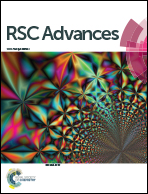In situ formation of gold nanoparticles on magnetic halloysite nanotubes via polydopamine chemistry for highly effective and recyclable catalysis†
Abstract
In this study, we present a simple and green approach to fabricate a magnetic halloysite nanotube (MHNT) supported Au nanoparticle (NP) composite (MHNTs–PDA–Au) with a polydopamine functional coating for highly effective and recyclable catalysis. The fabrication of MHNTs–PDA–Au involves decoration of Fe3O4 NPs on HNTs via a one-step co-precipitation method, deposition of a polydopamine layer on the MHNTs and subsequent in situ reduction of Au NPs via polydopamine chemistry. All the processes are simple and eco-friendly without use of additional toxic reagents and complicated treatment. The obtained MHNTs–PDA–Au composite exhibits excellent and versatile catalytic activity toward the reduction of various nitrobenzene derivatives and methylene blue dye when only trace amounts of Au catalyst are used. In addition, the catalytic system can be easily recycled for several cycles based on its good magnetic properties. The synergistic combination of MHNTs, polydopamine coating and metal NPs offers a versatile platform for design of natural HNT based composite materials and will expand the applications of HNTs in heterogeneous catalysis, water purification and green chemistry.


 Please wait while we load your content...
Please wait while we load your content...